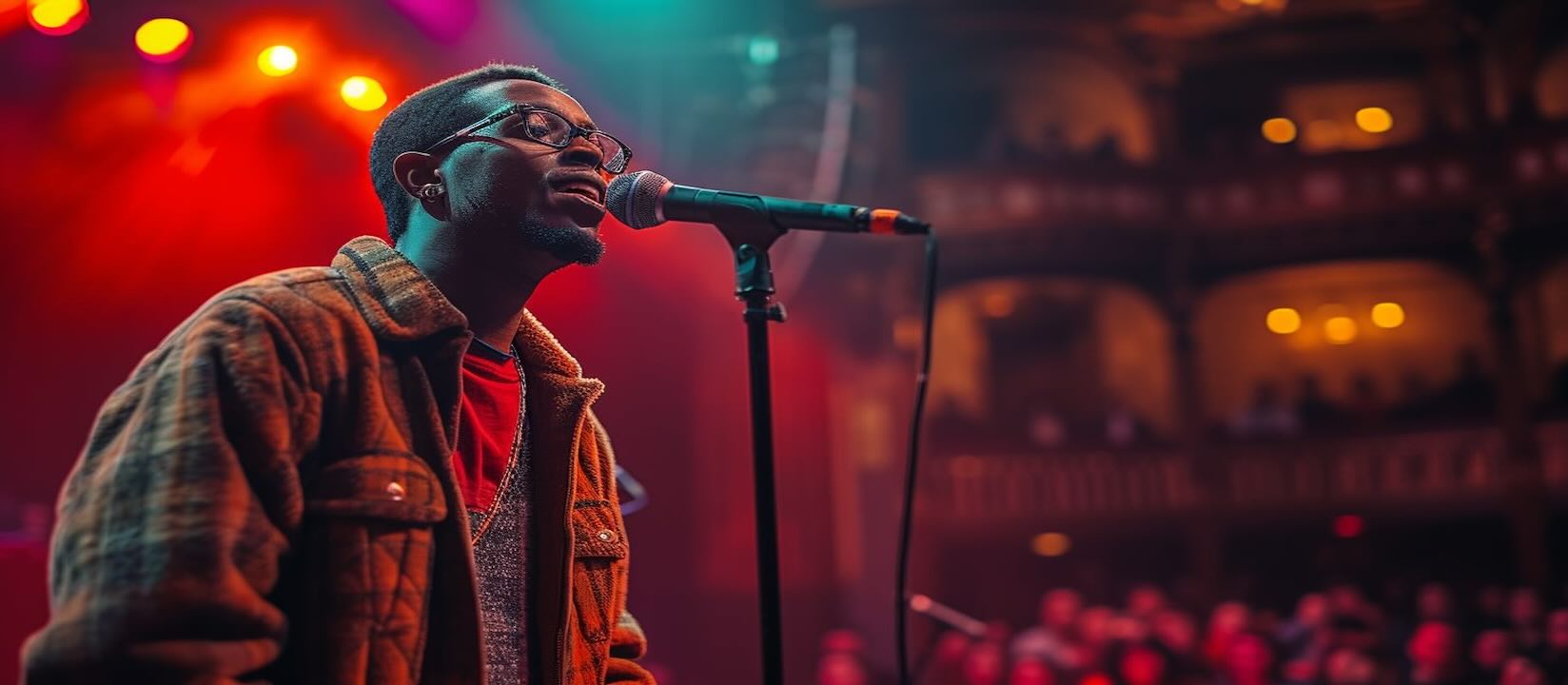
Deciding between stand-up and improv shows can feel like choosing between chocolate and vanilla. Both are deliciously entertaining in their own right, but they offer distinct flavors of comedy that cater to different tastes. We’re here to help you navigate the laughter-filled world of stand-up and improv, ensuring you pick the perfect comedic treat for your night out.
Stand-up comedy is a solo flight, where comedians deliver carefully crafted jokes and stories, aiming to connect with you through shared experiences and observations. Improv, on the other hand, is the wild card of comedy. It’s a team effort, where performers create spontaneous scenes based on audience suggestions, leading to unpredictable and often hilarious outcomes. Let’s dive into the nuances of each to help you decide which show will have you clutching your sides in laughter.
Comparing Stand-up and Improv Shows
When we delve into the heart of stand-up versus improv shows, we’re not just comparing two styles of comedy; we’re exploring two vastly different experiences that cater to diverse audiences.
Stand-up comedy is the art of the solo performance. It’s a space where comedians share their crafted stories, jokes, and observations. The key here is the connection between the performer and the audience, often built on relatable experiences or comical takes on everyday life. Stand-up comedians spend hours, sometimes even years, honing their material to perfection. This meticulous preparation aims to evoke a consistent, planned reaction, ensuring that every performance can appeal broadly, yet feel personal.
On the flip side, improv shows thrive on the unpredictable. They’re a team effort, where performers bounce off each other’s energy and the immediate feedback from the audience. Not a single show is the same because the content is spontaneously created, based on suggestions from the audience. This creates a dynamic and interactive atmosphere, making each performance uniquely engaging.
- Stand-up is polished and personal.
- Improv is spontaneous and interactive.
| Aspect | Stand-up Comedy | Improv Shows |
|---|---|---|
| Performance | Solo | Team effort |
| Preparation | Highly prepared | Spontaneous |
| Audience Role | Passive (Listener) | Active (Contributor) |
For those who appreciate a well-crafted joke and enjoy the artistry behind a solo performance, stand-up comedy might be more appealing. However, if you’re looking for an unpredictable night of laughter where you play a part in shaping the show, improv could be the right choice.
Understanding these core differences helps us appreciate the unique charm both stand-up and improv shows bring to the comedy scene. Each offers a distinct way to experience comedy, making it vital to consider personal preferences when choosing which to attend.
What to Expect at a Stand-up Show
Stand-up comedy, a space where humor intersects with the personal, offers a unique entertainment experience we’ll delve into. Understanding what stand-up entails, its structure, and the various types of performances can help you decide if it’s the right choice for you.
The Basics of Stand-up Comedy
At its core, stand-up comedy is about storytelling and connection. Performers, or comedians, take the stage solo to deliver a series of jokes, stories, and observations that they’ve finely honed. The goal? To resonate with you, the audience, on a personal level. Preparation is key in stand-up. Unlike in improv, where spontaneity reigns, stand-up comedians invest countless hours into refining their material. They aim to weave together humor and life experiences in a way that’s both entertaining and relatable. It’s this meticulous crafting of content that distinguishes stand-up from other comedic forms.
Structure and Format of a Stand-up Show
Understanding the structure of a stand-up show can enhance your viewing experience. Here’s a typical layout:
- Opening Act: Often, a lesser-known or local comedian warms up the crowd.
- Feature Act: A mid-level performer with more experience takes the stage to set the tone for the headliner.
- Headliner: The main event. This is usually a well-known comedian with a longer set designed to cap off the evening.
Shows typically last from 90 minutes to two hours, providing an ample dose of laughter in a single sitting. The curated flow ensures that energy levels build through the evening, making for a memorable and engaging experience.
Different Types of Stand-up Performances
Stand-up comedy is a broad church, encompassing a range of styles and subjects. Here are a few you might encounter:
- Observational Comedy: Focuses on everyday life, pointing out the humor in common experiences.
- Political Comedy: Takes a stance on current events and political figures, often with a satirical edge.
- Blue Comedy: Leans into adult themes and language for humor.
- Alternative Comedy: Breaks traditional conventions, experimenting with format and content.
Each type offers a different lens through which to view the world, promising a diverse range of entertainment options within the stand-up genre. Whether you’re into lighthearted observations or more thought-provoking fare, there’s likely a stand-up style that aligns with your tastes.
What to Expect at an Improv Show
The Basics of Improvisational Comedy
When we dive into the world of improvisational comedy, or improv as it’s commonly known, we’re stepping into an unpredictable and thrilling realm of live entertainment. Improv hinges on performers creating spontaneous, unscripted comedy based on suggestions from the audience. This means no two shows are ever the same. Unlike stand-up, where comedians deliver carefully crafted monologues, improv relies on the fast thinking and collaborative spirit of its performers. The beauty of an improv show lies in its momentary nature; what happens on stage is often fleeting, leaving us with unique and unforgettable experiences.
Principles and Techniques of Improvisation
Improv is not just about making people laugh; it’s rooted in a set of principles and techniques that guide performers in their quick-witted exchanges. Among the most pivotal is the concept of “Yes, and…” which encourages performers to accept what their fellow players offer to the scene (the “yes”) and then add to it (the “and”). This principle fosters a collaborative environment ripe for comedy. Other techniques include advancing the scene by adding new information, exploring relationships between characters, and using physical space effectively. These techniques ensure that improv scenes are dynamic, engaging, and most importantly, comedic.
Types of Improv Performances
Improv comes in various forms, offering something for everyone. Here’s a quick breakdown:
- Short-Form Improv: Comprised of quick, game-like scenes often driven by audience suggestions. Shows like “Whose Line Is It Anyway?” popularized this format.
- Long-Form Improv: Involves longer scenes that could last up to an entire show, often weaving together various stories and characters. This format allows for more in-depth narratives to unfold.
- Musical Improv: Where performers create musical scenes, complete with improvised songs and dances.
- Experimental Improv: Pushes the boundaries of traditional improv, incorporating unique themes, styles, or elements (like incorporating technology).
Whether you’re drawn to the lightning-fast pace of short-form improv, the narrative depth of long-form, the catchy tunes of musical improv, or the innovative spirit of experimental shows, there’s an improv performance that’s bound to capture your imagination and tickle your funny bone. Each style offers a distinct flavor of improvisation, showcasing the versatility and creativity of its performers.
Which Show is Right for You?
Choosing between stand-up and improv shows can feel like a daunting decision. However, by considering your personal preferences, your desired level of audience participation, and your comedy style inclinations, you can find the event that suits you best. Let’s dive into these aspects to help guide your choice.
Considering Personal Preferences
First and foremost, we need to consider what we’re looking to get out of the comedy experience. Are we seeking a polished performance with carefully crafted jokes and stories? If so, stand-up might be more our style. Stand-up comedians spend hours refining their material, ensuring each punchline hits just right. On the other hand, if we’re drawn to the thrill of the unexpected and appreciate the art of storytelling on the fly, improv shows could be more engaging for us. Improv offers a unique experience with each performance, rooted in spontaneity and the creative interplay between performers.
Preferred Level of Audience Interaction
One key aspect that differentiates stand-up and improv is the level of audience interaction. In stand-up comedy, interaction with the audience might be limited to a few crowd work moments, where the comedian engages directly with attendees. However, these interactions are usually controlled and serve to enhance the comedian’s material.
Improv, by contrast, thrives on audience participation. Suggestions from the audience often serve as the foundation for the entire performance, making attendees a vital part of the show. If we’re someone who enjoys being part of the action and potentially influencing the direction of the performance, improv is likely the better choice for us.
Comedy Styles and Preferences
Lastly, our preferences in comedy styles will significantly influence our choice between stand-up and improv. Stand-up comedy encompasses a wide range of styles, including but not limited to observational comedy, dark comedy, clean comedy, and satire. This variety ensures that there’s something for every taste, from light-hearted musings on daily life to sharp political commentary.
Improv also covers a broad spectrum of comedy but does so in a way that is inherently unpredictable. The style of an improv show can change dramatically based on audience suggestions and the performers’ interpretations. This means that an improv show can effortlessly shift from slapstick humor to surreal comedy sketches within the same performance.
Understanding our own comedy preferences, how much we want to interact with the performance, and what we’re hoping to get out of the experience can greatly assist in making the decision between attending a stand-up show or an improv show. By reflecting on these preferences, we’re better positioned to choose the option that will provide us with the most enjoyable and fulfilling experience.
Key Takeaways
-
Distinctive Comedy Experiences: Stand-up comedy is akin to a solo performance where the comedian connects with the audience through meticulously crafted jokes and stories. Improv comedy, on the other hand, is a collaborative endeavor, thriving on spontaneity and audience participation, resulting in unique and unpredictable performances.
-
Crafted Versus Spontaneous: Stand-up is characterized by high preparation, where comedians refine their acts over time to elicit consistent laughter. Improv is the art of the unexpected, relying on performers’ quick wit and the dynamic contributions of the audience to shape the show.
-
Audience Role: In stand-up, the audience primarily plays a passive role, enjoying the performance. Conversely, in improv, the audience actively contributes, influencing the direction and content of the performance.
-
Personal Preferences Matter: Your choice between stand-up and improv should be influenced by your comedic tastes. If you appreciate well-crafted humor and solo performances, stand-up is likely your preference. If you’re drawn to the thrill of unpredictability and enjoy a more interactive comedy experience, improv will likely appeal to you more.
-
Understanding Stand-up Comedy: This form is all about storytelling, personal connection, and the comedian’s ability to resonate with the audience through relatable content. The structure of a stand-up show typically includes an opening act, a feature act, and a headliner, offering a well-rounded comedic experience.
-
Exploring Improv Comedy: Improv is grounded in the principles of spontaneity, with performances created on the spot based on audience suggestions. This form of comedy is versatile, encompassing short-form, long-form, musical, and experimental improv, each offering a unique entertainment experience.
-
Making the Right Choice: Reflect on what you seek in a comedy show—whether it’s the polished narratives of stand-up or the spontaneous creativity of improv. Consider your preferred level of audience participation and the style of comedy that resonates with you the most.
Conclusion
When deciding between stand-up and improv shows, it’s essential to consider what we’re looking for in a comedy experience. Stand-up usually offers a more structured and predictable form of entertainment, where we can appreciate the craft of joke writing and the delivery of a well-rehearsed set. On the other hand, improv thrives on unpredictability and the seamless flow of ideas, making each performance unique and directly influenced by the audience’s energy and suggestions.
Stand-up is often seen as a solo journey, showcasing individual talents and perspectives. It’s a space where comedians share their observations, experiences, and insights, crafting a narrative that connects with us on a personal level. For those of us who enjoy a more contemplative comedy experience, where the punchlines are meticulously designed to elicit laughter, stand-up may be the ideal choice.
Improv, by contrast, is a team effort. It’s about the collective creativity and quick thinking of the group, which can lead to unexpected and often hilarious outcomes. If we’re drawn to the spontaneous and collaborative nature of comedy, where the outcome is as much a surprise to the performers as it is to us, then improv might just be our go-to. No matter which type of show you’re interested in, be sure to check online resources for comedy show tickets to find both improv and stand-up options near you!
| Comedy Type | Key Features | Ideal For |
|---|---|---|
| Stand-up | Structured, solo performances, rehearsed material | Those who appreciate crafted jokes and stories |
| Improv | Spontaneous, collaborative, unique performances | Fans of unpredictability and audience input |
In essence, our choice depends on whether we lean towards the polished and personal appeal of stand-up or the dynamic, interactive aspect of improv.
Frequently Asked Questions
What is stand-up comedy and how does it differ from improv?
Stand-up comedy is a form of comedy where performers deliver a pre-written, rehearsed set of jokes, stories, and observations to entertain an audience. It contrasts with improv comedy, which is completely unscripted, relying on spontaneous performances based on audience suggestions.
What can I expect at a stand-up comedy show?
At a stand-up show, expect a structured performance with an opening act, a feature act, and a headliner. Comedians share their finely honed material, aiming to connect through storytelling and humor. The content may range across various styles, from observational comedy to political jokes.
What is improvisational comedy?
Improv comedy involves performers creating unscripted comedy spontaneously, based on audience suggestions. It emphasizes collaboration and the principle of “Yes, and…” where performers build on each other’s ideas. It includes various forms like short-form, long-form, and musical improv.
How do I decide between a stand-up and an improv show?
Your decision should be based on personal preference for the type of comedy, desired level of audience participation, and comedy style inclination. If you prefer polished jokes and stories with limited interaction, choose stand-up. If you enjoy spontaneity and direct engagement, improv might be more your style.
Does stand-up or improv involve more audience participation?
Improv comedy involves a significant level of audience participation, as suggestions from the audience drive the performance. In contrast, stand-up comedy generally involves limited direct interaction, with the comedian delivering their prepared material.
Can stand-up comedy encompass different comedic styles?
Yes, stand-up comedy encompasses a wide range of styles, including observational comedy, political comedy, blue comedy, and alternative comedy. This diversity allows for a broad spectrum of entertainment options within the genre.



Leave a Reply